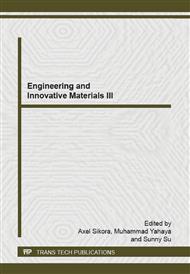p.91
p.96
p.101
p.105
p.109
p.114
p.119
p.124
p.129
Electroless Deposition of Silver Nanoparticles and Nanowires in Ethylene Glycol
Abstract:
Silver (Ag) nanostructures, such as nanoparticles and nanowires, were formed by electroless deposition in ethylene glycol at 160 °C for 1h. Polyvinyl pyrrolidone (PVP) were used both as a capping agent and structure-directing agent to prevent agglomeration and promote the growth of Ag nanowires. The effect of its molecular weight and concentration on the morphology of Ag was examined by X-Ray Diffraction (XRD) and scanning electron microscopy (SEM). XRD analysis showed peaks corresponding to the face-centered cubic (FCC) structure of metallic silver. At low PVP molecular weight of 10,000, spherical Ag nanoparticles with a mean diameter of about 170 nm were formed. A mixture of Ag nanoparticles and nanowires were produced when the molecular weight was increased to 55,000 and 360,000.
Info:
Periodical:
Pages:
109-113
Citation:
Online since:
October 2014
Keywords:
Price:
Сopyright:
© 2014 Trans Tech Publications Ltd. All Rights Reserved
Share:
Citation:


